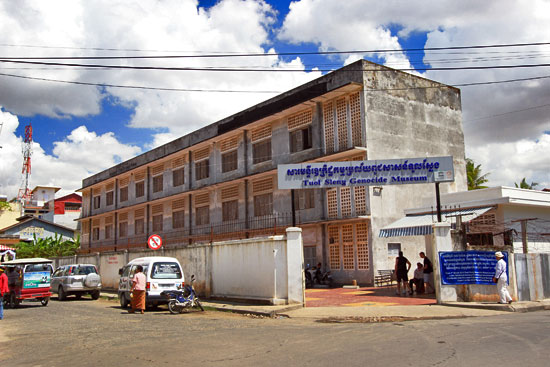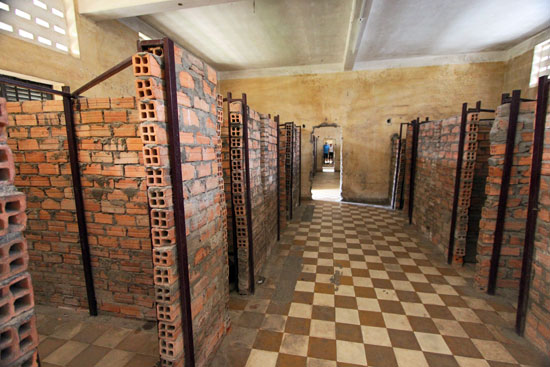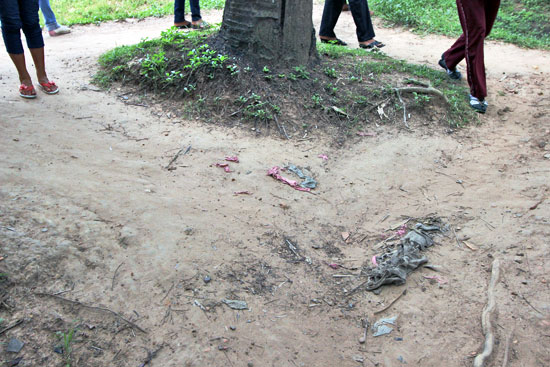The ocean of tuk tuks, motorcycles, and pedestrians in downtown Phnom Penh parted around me like the Red Sea. An uneasy feeling niggled; something wasn’t quite right but I couldn’t put my finger on it. I returned a smile from a pajama-clad Khmer woman on her daily shopping rounds and suddenly realized that my face was the only one with wrinkles; of the Cambodians, not a single person on the street appeared to be over the age of 45. I puzzled over my observation a few seconds longer but then set aside my curiosity as I headed out for a day of sightseeing.

My first stop was the Tuol Sleng Genocide Museum, a former school that had been converted into Security Office 21 (S-21) during the Khmer Rouge years. From the outside, the dingy grey cinder block building looked very much like the school it had once been, but once inside the sinister nature of the facility quickly revealed itself. In some classrooms, brick walls had been erected, dividing the space into facing rows of 2.6 x 6.5 foot cells with no ceilings or doors. Windows in rooms used specifically for torture were paneled with glass to deaden the sound the prisoner’s screams, while the buildings exteriors were covered in barbed wire to prevent prisoners from committing suicide by jumping down. I wandered from room to room, examining photos of the 14 horribly mutilated bodies discovered in this facility on the day in 1979 when Phnom Penh was liberated and reading about the atrocities committed by Pol Pot and one of his most trusted cohorts, Duch, who was personally responsible for day-to-day operations at S-21.
Khmer Rouge forces, under the leadership of the despot Pol Pot, took Phnom Penh on April 17, 1975, effectively seizing power over all of Cambodia. Immediately, residents of the capital were forced to evacuate to the countryside, leaving their homes and possessions behind. Though the Khmer Rouge painted this as a protective measure, telling people that American bombings were imminent, Pol Pot’s true intent was to impose a system of agrarian communism similar to that espoused by Mao Zedong. In the years prior to capturing Phnom Penh, Pol Pot had been frustrated by how quickly Cambodians, left to their own devices after Khmer Rouge forces marched on, would return to their capitalist ways. Sending city dwellers to the country was his means of ensuring success for the communist utopia he envisioned.

Dubbed the “new people,” these relocated urbanites were targeted for destruction. After being resettled in communes, they were forced to dig ditches and perform other manual labor, while being fed only two bowls of rice soup per day. Thousands died of starvation. Those seen as a special threat – Buddhist monks, teachers, intellectuals, ethnic minorities – were taken to S-21 for interrogation, using extreme methods of torture to extract confessions deemed useful to the government.
There are no exact figures for the number of Cambodians who perished in the four and a half years that Pol Pot ruled, but estimates range from 750,000 to more than three million. I thought about those numbers as I gazed through the barbed wire to the wooden pole in the yard that was once used for physical education classes but had been converted to an instrument of torture. Prisoners were stood with their backs against the pole and their hands tied behind their backs. The interrogator lifted the prisoner upside down a number of times until he or she lost consciousness, then dipped the prisoner’s head into a bucket of filthy water. This shocked the victims back to consciousness so that the torturer could continue questioning. One handwritten account from a guard described how he gave his baton to another guard when he grew tired from beating the man he was questioning so the torture could continue uninterrupted.
Intellectually, I was appalled. “What kind of animal must someone be to inflict such horrible things on another human being,” I wondered. Yet, I was strangely devoid of any feelings, even after viewing a glass display case containing heaped skulls and bones found at S-21 after the city was liberated. I had learned about a similar decimation of the population in Laos, when the U.S. dropped more than two tons of bombs for every man woman and child in the country during the Vietnam War years, and visited museums in Hanoi, Vietnam where photos of horribly disfigured corpses resulting from the use of Agent Orange were displayed. More recently, while visiting Peru, I learned about the brutal eradication of indigenous tribes by Spanish Conquistadors. “Perhaps I have seen so much incomprehensible evil that nothing shocks me anymore,” I thought.
Can’t view the above Slide show about the Killing Fields of Phnom Penh, Cambodia? Click here.
Numbly, I left Tuol Sleng and hopped into a cyclo-rickshaw for the 10 mile ride to Choeung Ek Genocidal Center, best known of the 300 Khmer Rouge Killing Fields that have been discovered around Cambodia. At the entrance I picked up a set of headphones for an audio tour around the mass graves of the estimated 17,000 victims, most of whom who were executed after arriving from the S-21 Prison. At each marker I listened solemnly to the horrific stories about the site, in some instances narrated by a rare survivor. At the far end of the field I stopped in front of a small fenced area surrounding a shallow depression from which 450 bodies had been exhumed. On the other side of the fence, similar depressions pocked the grassy field as far as I could see. At each of these pits, victims were made to kneel and then were bludgeoned to death with shovels, axes or clubs, since bullets were in short supply. As the recording spun out the grim details I kicked the barren ground in front of the mass grave with the toe of my sandal, kicking up a small plume of buff colored dirt. When the dust settled, a small shard of bone lay exposed at my feet. I picked it up and gently laid it inside the fence. More than 30 years later, bones continue to emerge from the ground after every rain.

Near the end of the tour, I joined a group of Cambodians gathered around a large tree covered in prayer bracelets. Three monks hugged bright orange robes tightly around their bodies, as if they were cold despite the 90 degree temperatures. One looked up as if beseeching heaven. Another gazed unseeing toward the horizon. The third read the sign in front of the tree: “Killing Tree Against Which Executioners Beat Children.” Hundreds of children were murdered here by bashing their heads into the tree. Though Pol Pot was never tried for his crimes and apparently never showed any remorse for his part in the genocide prior to his own death in 1998, this tree was the undoing of Duch, the mastermind of S-21, who denied any wrongdoing after his arrest until he was brought back to this very tree during his trial. He broke down and cried, begging forgiveness for his actions, claiming that he had not remembered any of it until seeing the tree.

Still bereft of feeling, I bowed my head and turned toward the Buddhist Memorial in the center of Choeung Ek to offer a moment of silent prayer, when I noticed scraps of colored cloth protruding from the ground in every direction. Curious, I squatted down to examine the faded material more closely and abruptly realized that they were fragments of the victims’ clothing, working their way up through the soil after all these years. I recognized a button hole and made out what looked like a piece of raincoat. Feeling as if I’d been punched in the gut, I gasped for breath. Those scraps of clothing impacted me in a way that the photos of heaped skeletons, the audio narration, or even the killing tree had not. Perhaps because the remnants were on the marked trail where visitors walked, rather in the mass grave pits, I finally understood the magnitude of the site. Bodies lay below every square inch of topsoil at Choeung Ek.
I looked up at the young Cambodians who had come to learn about their history and the final piece of the puzzle clicked into place. The dearth of older people in Cambodia is easily understood. According to the United Nations Population Division, nearly 82% of the population of Cambodia is under the age of 45. The older folks were all killed by the Khmer Rouge, and a whole lot of them lay beneath my feet that day.

I’m so glad to hear from your website, Barbara.
When I was stationed in West Germany, I studied the concentration camps in Germany, and have since walked upon the sacred grounds of the Indigenous people now occupying minuscule portions of lands they once roamed, in what is called America and discovering their intentional genocide by European settlers and the US government using measles, chicken pox, mumps, and smallpox infections that decimated people who had occupied a continent for over ten-thousand years.
I’m glad to hear from you, knowing you are safe, healthy, and happy.
i just visited cambodia last week march 5-11 siem reap then phonm pehn and i can’t stop myself from crying esp when we went to killing field and s21…i cried so much for the pain that everyone has been thru esp kids being turtored . Heartbreaking . I can’t still believe it really happen…PRAYERS TO ALL VICTIM !!
Hi Rowena. I feel your pain. The experience affected me much the same way. Blessings.
I remember visiting both of these places in 2003. We didn’t know what to expect then and both of us were overcome with emotion. It was quite overwhelming and difficult to put into words. I don’t understand how anyone can inflict this much pain and suffering, and yet it keeps happening again and again throughout history.
I hear you, Deb. I had the same gut-wrenching, visceral reaction. How can this stuff happen over and over again. Beyond my comprehension. But maybe if we keep this stuff in the public conscience with articles it will help, if even a little. Thanks for reading and your comment. Wish we could spend some quality time together at some point.
This is such an interesting and touching post. Thanks very much for sharing.
The Khmer Rouge were Communists of the Chairman Mao variety; Vietnam was a Soviet client state, therefore Cambodia went to China as a counterbalance. Mao said 2 things: “Power comes from the muzzle of a gun,” and “Kill one, strike fear into the hearts of ten thousand.” Maoism is the most violent form of Communism found anywhere in the world – e.g. Cultural Revolution, Sendora Luminosa Shining Path, Japanese Red Army, Communist Party of Nepal, and the Khmer Rouge. Maoism = Genocide
This must have been emotionally devastating for you, Barbara, knowing your empathy. When Mary and I visited an old prison camp used by the Noriega regime on Coiba Island off the coast of Panama, it was difficult to shake the feeling of being surrounded by the ghosts of the men that laid interred in the ground all around us– the horror and abject misery these people suffered due to one man’s hunger for absolute power. Just remembering it brings back feelings of sadness and anger, so I can’t imagine how the Cambodian people must feel.
Wow, such a touching story. Thanks for sharing.
A few years ago I visited Auschwitz Birkenau, it took me the whole day, and I’m not even sure I even smiled the two days that followed. I have to admit I know too few about the Khmer Rouges. I know the basics, not the facts, not the figures. And now, I can understand your feeling when you first stepped into the Genocidal Center. While visiting Birkenau, I was wondering how nature could still go on around the place. I guess the same happened with your tree, and the dirt… Earth reminds you everyday what happened there by giving you pieces of it…
Great article, really sad thoughts, but that’s our duty to know what happens and pass it on to new generations.
Completely understand. I was in the former KGB-prison in Vilnius yesterday and found it hard to breathe. As if the horror was embedded in the walls. It’s difficult, but very necessary to see and feel these places.
We are such an amazing species, with the imagination to create wonder, and also to perform unspeakable acts upon each other. Stuff like this really boggles me. And the fact that it continues to happen around the world boggles me even more. I have no idea when humanity is going to grow up, but I wish we’d hurry up about it.
This was one of the hardest days of travel for me, visiting the killing fields and the school. It’s just so hard to wrap your mind around it all. Listening to that audio guide at the killing fields was rough, especially the parts from the survivors. I just can’t imagine how anyone could think to do those horrible things to another human being.
Such a sad history
Barbara, this is written with honesty and integrity. You have honored the victims and I felt a profound compassion for all humankind. I am proud you have the courage to tell the story , and maybe it will help all of us feel a liile more connected so that when we hear such incomprenhisible acts, we will rise up together with one voice , to stop further violations against basic human rights.
Thanks P. Scott. One of the things that mystifies me is how so few could control so many. It’s the same with almost any ethnic cleansing – the victims offer little resistance and just go to the slaughter. If only they had resisted, they could have easily stopped the Khmer Rouge – as you say, rising up together. I pray there won’t be a next time.
S-21 and the Killing Fields are two places I will never forget, and hopefully never return too. Like you I was horrified, and to grasp what happened here is almost impossible. I think these are two places that every traveler in SEA should see once. I even had a difficult time reading your post, and it’s been years since I visited these places.
Hi Nancie: Like you, I was horrified, but thought it was very important to experience it Killing Fields and learn as much as I could, especially since I write about culture and this recent history has had such a strong influence on Khmer culture.
I’d heard about this place and I must admit, although I wouldn’t find it pleasant, it is an important experience to go to such places to recognise what humans are capable of And yet in our recent past we still have such things happening – Rwanda, Bosnia and it seems the world can look on. A little ironic that the fate of Laos and Vitenam don’t have quite so much publicity – history is written by the powerful
Profound observation, Heather
trial that is 🙂
ps Comrade Duch is now in prison in Cambodia serving a life sentence. He is the first to even be up on trail.
Hi Vaya: I know – I was amazed that it took so long to bring him to justice. Thirty-plus years. Sickening and heart-rending.
When we visited Cambodia a few years back, we didn’t want to go to these two places. However, we got “talked” into it by a tuk tuk driver. I have to say that I am glad to have seen them. I taught Cambodian refugees for many years, and only wish that I had known more about what their families had endured.
I agree that Phnom Penh is a ying-yang kind of a place.
Great, tough article! Even though I am very familiar with these stories, I’m still left speechless.
Thank you all for your comments. It was a very tough article to write – took me a long time to get it out
A powerful account. I shall be visiting there next year to complete my journey to visit the three biggest locations of holocausts. Places like these should be visited by everyone to witness the atrocities that we as humans are capable of inflicting on one another.
On a lighter note, may I ask what’s the name of the slideshow plugin you have displayed during the post?
Hi Carlo: I use a plugin called SliderPro, which is a paid plugin ($25, as I recall). It’s not particularly intuitive but there are extensive documentation and help files available, and the developer is very good about helping out, even to the extent of making changes on the site for you.
OMG. What an experience. I am trying to relate and cannot. Auschwitz must have the same sobering revelations.